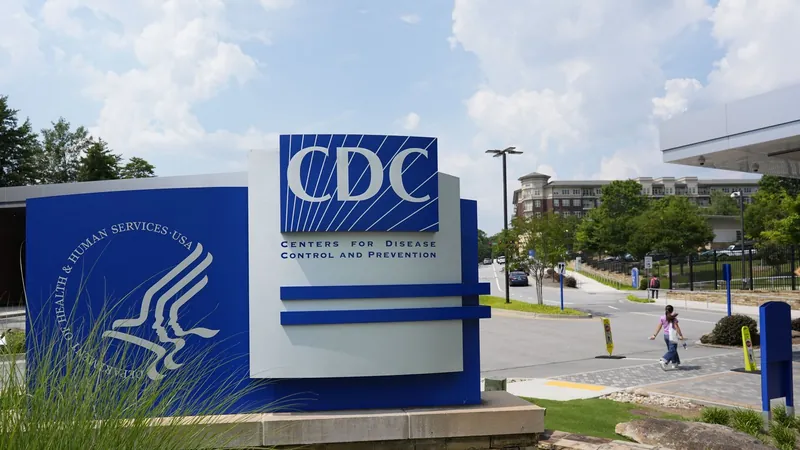
Why Your Muscle Growth Might Be Stalled – And How to Jumpstart It Now!
2024-12-31
Author: Emma
Why Your Muscle Growth Might Be Stalled – And How to Jumpstart It Now!
When it comes to building muscle, there’s no one-size-fits-all answer. Picture this process as a complex puzzle, where genetics, lifestyle choices, and effective strategies come into play. While some people see gains almost instantly, others may feel perpetually stuck despite their dedication. Understanding the key elements that affect muscle growth—like body composition, nutrition, and training techniques—can unlock your potential and transform that frustration into tangible results.
We’ve delved deep into expert insights and scientific research to reveal why your muscle gains may be lagging. Plus, we’ll share some actionable strategies to tweak your daily routine for optimal muscle-building success. Keep reading to discover how to turn the odds in your favor!
The Role of Genetics and Hormones
A significant factor impacting muscle growth is genetics. They not only shape your physiological capabilities but also determine how your body responds to exercise.
Hormonal Influence
Anabolic hormones—namely growth hormone, estrogen, insulin, and testosterone—are critical for muscle development. Surprisingly, both estrogen and testosterone are essential for muscle structure and function. Testosterone, which is usually ten times higher in men, facilitates muscle growth, whereas estrogen enhances muscle mass and strength while supporting the integrity of connective tissues such as bones and tendons.
Ryan Turner, a registered dietitian and founder of Food is Fuel NYC, emphasizes that aging leads to a decrease in both testosterone and estrogen, contributing to muscle loss over time. Additionally, factors like stress reflect hormonal fluctuations that can hinder muscle growth. To optimize your progress, closely monitor your stress levels, sleep quality, and dietary habits.
Muscle Fiber Types
Muscle composition also varies from person to person. Your body contains both fast-twitch and slow-twitch muscle fibers, each serving distinct purposes. Fast-twitch fibers are responsible for powerful, explosive movements, while slow-twitch fibers help sustain endurance activities.
Genetically, some individuals are predisposed to have a higher proportion of either fiber type, with fast-twitch fibers being crucial for achieving significant muscle growth. Genetic markers, such as the ACTN3 and ACE genes, play a vital role in determining your fiber composition. Remember, while genetics can establish a ceiling for muscle development, rigorous training is necessary to achieve your full potential.
Nutrition: You Are What You Eat!
Nutrition holds immense influence over muscle gain. Proper diet is essential not only for adding muscle but also for maintaining it. According to Tami Smith, a certified personal trainer and CEO of Fit Healthy Momma, muscle tissue is energetically expensive, warranting conscious decision-making regarding your food intake.
A diet rich in calories and protein is vital for recovery and growth following workouts. Consuming adequate protein, especially following strength training, is critical for minimizing muscle protein breakdown and promoting muscle synthesis. Turner suggests that strength trainers need more protein than the average person, with recommendations for significantly increased caloric intake depending on training history and goals.
Did you know that fear of gaining weight often holds women back from building muscle? Many feel pressured to stay small and avoid any increases on the scale, mistakenly equating muscle gain with failure. However, as Smith points out, increasing muscle mass can positively alter one's appearance and change how weight reflects on the scale. Embracing muscle gain can lead to a stronger, healthier body.
The Power of Training (And Recovery)
With nutrition on track, let’s discuss training strategies. There are two types of muscular hypertrophy: myofibrillar (which builds strength) and sarcoplasmic (which increases muscle volume). Your training approach should align with your fitness goals.
To achieve muscle mass, heavier weights and lower repetitions (typically six reps or fewer) are essential. On the other hand, lifting lighter weights with higher repetitions (up to 15) can yield a more defined look, but at the cost of maximal strength.
In addition to a solid workout routine, restful sleep is crucial for recovery. Aim for at least 7-9 hours of quality sleep to optimize muscle repair and hormonal balance. Neglecting rest can sabotage your progress by inhibiting growth hormones.
Strength training offers numerous benefits beyond muscle gain: boosting metabolic rate, improving blood sugar control, reducing injury risk, and enhancing mental well-being. Aiming for two to three strength sessions per week can set a solid foundation; however, consider working with a personal trainer for a tailored approach to fit your objectives and keep you motivated.
Key Takeaways
Muscle-building potential isn't a universal trait; it varies widely among individuals. While genetics lay the groundwork, the pathways to developing muscle are shaped significantly by effort, nutrition, and training strategy. If you harbor dreams of increasing muscle size or strength, focus on a strategic approach to caloric intake, protein consumption, and a robust strength training program.
Are you ready to break through your muscle growth plateau? Don’t wait any longer—start making these changes today to unlock your true fitness potential!









 Brasil (PT)
Brasil (PT)
 Canada (EN)
Canada (EN)
 Chile (ES)
Chile (ES)
 Česko (CS)
Česko (CS)
 대한민국 (KO)
대한민국 (KO)
 España (ES)
España (ES)
 France (FR)
France (FR)
 Hong Kong (EN)
Hong Kong (EN)
 Italia (IT)
Italia (IT)
 日本 (JA)
日本 (JA)
 Magyarország (HU)
Magyarország (HU)
 Norge (NO)
Norge (NO)
 Polska (PL)
Polska (PL)
 Schweiz (DE)
Schweiz (DE)
 Singapore (EN)
Singapore (EN)
 Sverige (SV)
Sverige (SV)
 Suomi (FI)
Suomi (FI)
 Türkiye (TR)
Türkiye (TR)
 الإمارات العربية المتحدة (AR)
الإمارات العربية المتحدة (AR)